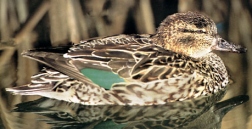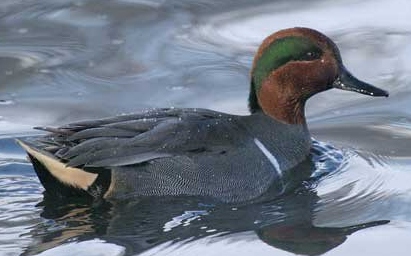|

Small dabbling
duck with pale, gray-barred sides and buff breast with a white bar down
the side. Head is chestnut-brown with green ear patch.
Bill is dark gray and legs and feet are olive-gray to gray-brown.
Speculum is flashy green bordered with brown above and white below.
The male Green-winged Teal has pale gray-barred sides and spotted buff
breast with a vertical white stripe down the side. The head is chestnut
with a green ear patch.

|
GREEN-WINGED
TEAL
Anas crecca
ANSERIFORMES
Geese and Ducks (Anatidae)
Range and Habitat
Breeds in northern Alaska, Manitoba, and Quebec south to California,
Colorado, Nebraska, and New York. Spends winters in southern states
and along the coasts. Preferred habitats include marshes, ponds, and
marshy lakes.
SOUND: "KRICK-et", "quack"
The American and Eurasian forms of the Green-winged Teal were formerly
considered different species.
It was considered conspecific with the Common Teal for some time, and
the issue is still being reviewed by the American Ornithologists' Union.

This is the smallest North American dabbling duck.
A group of teal has many collective nouns, including a "coil",
"dopping", "knob", "paddling", and "spring"
of teal.
The Green-winged Teal has a large range, estimated globally at over
10,000,000 kilometers. Native to the Americas, Europe, Asia, and Africa,
this bird prefers an inland wetlands ecosystem. The population is estimated
to be between 6,500,000
and 7,600,000 individuals globally and
does not show signs of decline.

|